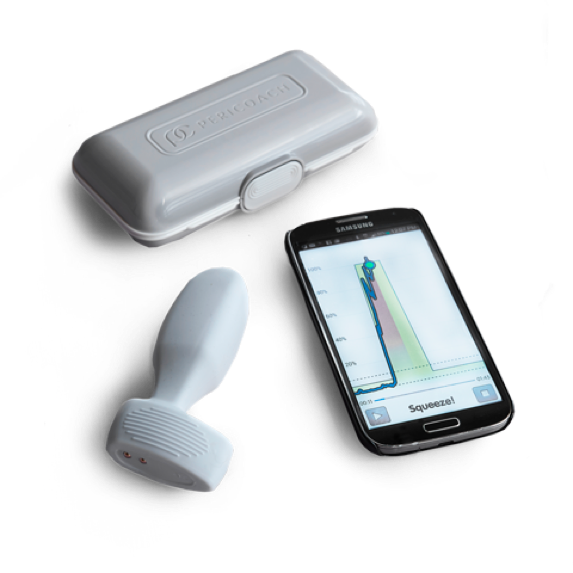The Importance of Kegel Exercises for Menopausal Women
Whether you’re tired of going through box after box of bulky bladder pads for embarrassing urine leakage or you’re trying to avoid ever needing bladder pads at all, we have good news: Getting urinary incontinence (UI) under control is possible with an assistive device like PeriCoach.
One in three women will experience some form of UI in her lifetime. Perhaps because it’s so common a frequent misconception persists: that incontinence is an inevitable part of aging. Not so.
Menopause and Bladder Leaks
Like it or not, mature women are more likely to experience UI. This is because of hormone-driven physiological changes that happen during menopause, including:
- Thinning of the urethra
- Reduced elasticity of vaginal tissue
- Weakened pelvic floor muscles
There are several types of UI, including stress incontinence, the most common form of UI, which causes you to leak urine when laughing, coughing, or sneezing. Other types of UI include urge incontinence, the sudden need to empty your bladder, and overflow incontinence, which happens when the bladder doesn’t empty properly.
Loss of muscle tone in the pelvic region during menopause can also lead to pelvic organ prolapse (POP), which occurs when an organ, such as the bladder, drops from its normal position and presses against the walls of the vagina. Organs that can prolapse include:
- Bladder
- Small bowel
- Rectum
- Urethra
- Uterus
- Vagina
When an organ like the uterus prolapses, it can push against the bladder or prevent the urethra from shutting completely, causing bladder leaks.
The Financial Burden of UI

Women in general are more likely experience urinary incontinence because of life factors like pregnancy, childbirth, and menopause, which can strain the muscles of the pelvic floor. Not only does UI reduce a woman’s quality of life, it can be quite expensive to treat.
One study found that American women spend $12.4 billion in direct costs dealing with UI every year.1 Women in the U.S. spend an average of $900 annually on routine care costs, which includes items like bladder pads and briefs, and odor control products.2
Perhaps the most dreaded of all incontinence maintenance products is the “adult diaper”—sales of which are soaring and are expected to increase significantly by 2020.3 Beyond these items, doctor visits, diagnostic costs, medications, etc., can add significantly to the cost of dealing with UI.
What if women could slash these costs dramatically and take control of their bladder function—at any age?
Your First Line of Defense Against UI
This is where PeriCoach comes in. The technologically-advanced insertable pelvic floor exerciser guides you through Kegel exercises and easily pairs with your smartphone via Bluetooth. With PeriCoach you can see on a squeeze by squeeze basis if you are doing your exercises correctly, track your progress over time, gradually increase your routine, and share your results with your physiotherapist.
Healthcare practitioners recommend training your pelvic floor muscles with Kegel exercises as your first line of defense against UI and pelvic floor prolapse. Yet, at least 50% of women do not correctly contract their pelvic floor muscles with verbal or written instructions alone. PeriCoach helps ensure you are consistently performing the exercises correctly for optimal results over time.
How to Do Kegel Exercises
Doing Kegels the right way requires practice. It’s easy to accidentally flex the muscles in your abdomen, thighs, or buttocks. To identify your pelvic floor muscles, stop your urine flow midstream. If you’re successful, you’ve identified the right muscles. As tempting as it may be to “kill two birds with one stone” though, don’t do Kegels while peeing, as it can cause bladder problems and urinary tract infections.
We recommend doing Kegel exercises while lying on your back with knees bent. But we also realize it isn’t always going to be practical to lie down, especially since you should aim for a set of 10 repetitions 3 times a day. Thankfully you can do Kegels while standing, sitting, or lying down.
Once in position:
- Squeeze your muscles.
- Hold for 5 to 10 seconds.
- Release and rest for 3 seconds.
- Repeat for 10 repetitions.
Avoid holding your breath during Kegels, which can cause you to tighten the muscles in your abdomen. Focus on breathing normally while contracting and relaxing your pelvic floor muscles, and make sure your abs, thighs, and glutes are relaxed.
If you’re not sure whether you’re doing the exercises correctly, insert a finger into your vagina and squeeze. You should feel the vaginal muscles lift and contract around your finger. Imagine trying to keep a marble from falling out of your vagina.
Also, you want to squeeze and hold rather than squeeze and pulse. Once your muscles are toned from regular pelvic floor exercises you can move on to more challenging exercises, like fast-twitch pulses.

How Often to Do Kegels
Aim for 1 set of 10 contractions, 3 times per day (morning, afternoon, and night). Committing to five minutes a day using a pelvic floor exerciser like PeriCoach can help you improve your form and motivate you to stick with your exercise routine. PeriCoach is portable and fits easily into your bag. Just like packing those tennis shoes, take it with you on a weekend trip away!
Overcoming Challenges
When you first start doing Kegels you may find it hard to hold a contraction for more than one or two seconds. Or you might have trouble keeping the contraction tight because your muscles aren’t yet toned enough.
Fear not, your muscle strength will improve over time with daily practice. PeriCoach will provide the visual biofeedback for you to stay motivated and see the progress over time. If for some reason you’re not seeing improvements within a few months of starting your daily exercise routine, let your doctor or physiotherapist know.
Who Shouldn’t Do Kegels
Even if you’re a menopausal woman who isn’t experiencing problems like bladder leaks or painful sex (due to hormonal changes), healthcare professionals generally recommend Kegel exercises for women as part of your daily routine. However, there are some exceptions.
If you have a condition like vaginismus—muscle spasms when something enters the vagina—avoid Kegel exercises, which can exacerbate the condition. If you’re experiencing pelvic pain, consult your doctor or pelvic floor physical therapist about doing Kegels.
Signs of Improvement
It’s not realistic to expect instant improvements in bladder leakage or orgasm intensity (it’s true—improved pelvic floor muscle strength can lead to longer, stronger orgasms).
But, if you stick with your daily Kegel routine, you could see improvements in your symptoms in as few as 4 weeks using PeriCoach. It may take up to 3 months before you experience noticeable results, though, so be patient, and keep Kegeling!
Benefits of Improved Pelvic Floor Strength
There are so many benefits to exercising your pelvic floor, including less reliance on costly, bulky pads, fewer worries about where the closest toilet is located while you’re out, and greater self-confidence and personal comfort. Strengthening your pelvic floor muscles can:
- Reduce or eliminate embarrassing bladder leakage
- Reduce the likelihood of pelvic organ prolapse (POP)
- Reduce or eliminate urinary/bowel incontinence
- Improve confidence and reduce anxiety
- Improve intimacy, sexual satisfaction, and the ability to reach orgasm
Don’t suffer with urinary incontinence—PeriCoach is now available over-the-counter without a prescription! Read what real women are saying about PeriCoach.
Sources
https://misuse.ncbi.nlm.nih.gov/error/abuse.shtml


